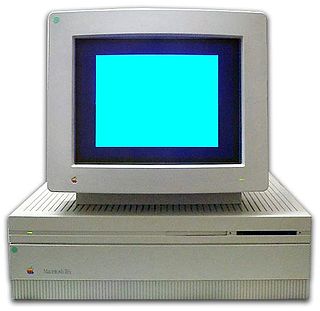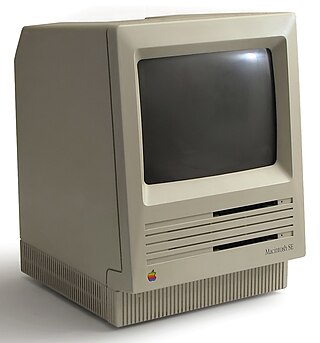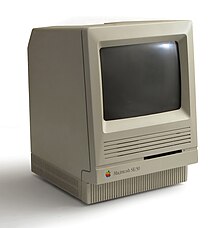
The Macintosh Plus computer is the third model in the Macintosh line, introduced on January 16, 1986, two years after the original Macintosh and a little more than a year after the Macintosh 512K, with a price tag of US$2,599. As an evolutionary improvement over the 512K, it shipped with 1 MB of RAM standard, expandable to 4 MB, and an external SCSI peripheral bus, among smaller improvements. Originally, the computer's case was the same beige color as the original Macintosh, Pantone 453; however, in 1987, the case color was changed to the long-lived, warm gray "Platinum" color. It is the earliest Macintosh model able to run System Software 5, System 6, and System 7, up to System 7.5.5, but not System 7.5.2.

The Macintosh II is a personal computer designed, manufactured, and sold by Apple Computer from March 1987 to January 1990. Based on the Motorola 68020 32-bit CPU, it is the first Macintosh supporting color graphics. When introduced, a basic system with monitor and 20 MB hard drive cost US$5,498. With a 13-inch color monitor and 8-bit display card the price was around US$7,145. This placed it in competition with workstations from Silicon Graphics, Sun Microsystems, and Hewlett-Packard.

The Macintosh IIfx is a personal computer designed, manufactured and sold by Apple Computer from March 1990 to April 1992. At introduction it cost from US$9,000 to US$12,000, depending on configuration, and it was the fastest Macintosh available at the time.

The Apple IIGS, the fifth and most powerful of the Apple II family, is a 16-bit personal computer produced by Apple Computer. While featuring the Macintosh look and feel, and resolution and color similar to the Amiga and Atari ST, it remains compatible with earlier Apple II models. The "GS" in the name stands for "Graphics and Sound", referring to its enhanced multimedia hardware, especially its state-of-the-art audio.

The Macintosh IIx is a personal computer designed, manufactured, and sold by Apple Computer from September 1988 to October 1990. This model was introduced as an update to the original Macintosh II, replacing the 16 MHz Motorola 68020 CPU and 68881 FPU with a 68030 CPU and 68882 FPU running at the same clock speed. The initial price of the IIx was US$7,769 or US$9,369 for the version with a 40 MB hard drive.

The Macintosh IIsi is a personal computer designed, manufactured and sold by Apple Computer, Inc. from October 1990 to March 1993. Introduced as a lower-cost alternative to the other Macintosh II family of desktop models, it was popular for home use, as it offered more expandability and performance than the Macintosh LC, which was introduced at the same time. Like the LC, it has built-in sound support, as well as support for color displays, with a maximum screen resolution of 640 × 480 in 8-bit color.

The Macintosh SE is a personal computer designed, manufactured, and sold by Apple Computer, from March 1987 to October 1990. It marked a significant improvement on the Macintosh Plus design and was introduced by Apple at the same time as the Macintosh II.

The Macintosh LC II is a personal computer designed, manufactured, and sold by Apple Computer from March 1992 to March 1993. The LC II is an update to the original Macintosh LC, replacing its Motorola 68020 processor with a 68030 and increasing the onboard memory to 4 MB. The LC II was priced at US$1,699, fully $800 less than the original LC when it was introduced.

The Apple Macintosh—later rebranded as the Macintosh 128K—is the original Apple Macintosh personal computer. It played a pivotal role in establishing desktop publishing as a general office function. The motherboard, a 9 in (23 cm) CRT monitor, and a floppy drive were housed in a beige case with integrated carrying handle; it came with a keyboard and single-button mouse. It sold for US$2,495. The Macintosh was introduced by a television commercial entitled "1984" shown during Super Bowl XVIII on January 22, 1984 and directed by Ridley Scott. Sales of the Macintosh were strong at its initial release on January 24, 1984, and reached 70,000 units on May 3, 1984. Upon the release of its successor, the Macintosh 512K, it was rebranded as the Macintosh 128K. The computer's model number was M0001.

The Macintosh IIcx is a personal computer designed, manufactured and sold by Apple Computer, Inc. from March 1989 to March 1991. Introduced six months after the Macintosh IIx, the IIcx resembles the IIx and provides the same performance, but is seven inches narrower, ten pounds lighter, and quieter due to a smaller internal fan. The relative compactness results in three NuBus slots being available, compared with six on the IIx.

The Macintosh TV is a personal computer with integrated television capabilities released by Apple Computer in 1993. It was Apple's first attempt at computer-television integration. It shares the external appearance of the Macintosh LC 500 series, but in black. The Macintosh TV is essentially a Performa 520 that can switch its built-in 14" Sony Trinitron CRT from being a computer display to a cable-ready television. It is incapable of showing television in a desktop window, although it can capture still frames to PICT files.

The Macintosh Classic II was a personal computer designed and manufactured by Apple Computer, Inc. from October 1991 to September 1993. The system had a compact, appliance design with an integrated 9" monitor, typical of the earliest of the Macintosh range. A carrying handle moulded into the case added a degree of portability at a time when laptops were still relatively uncommon.

The Macintosh IIvx is a personal computer designed, manufactured and sold by Apple Computer from October 1992 to October 1993. It is the last of the Macintosh II family of Macintosh computers. The IIvx was introduced at the same time as the Macintosh IIvi, with both models using the same metal case design as the earlier Performa 600 and Performa 600CD. Like the Performa 600CD, the IIvx could be equipped with an internal double-speed CD-ROM drive.
MODE32 is a software product originally developed by Connectix for certain models of the Apple Macintosh. It was published in June 1991 and originally cost US$169; however, on September 5, 1991, the software was made available free to customers under licensing terms with Apple Computer.

The Macintosh Quadra 605 is a personal computer designed, manufactured, and sold by Apple Computer from October 1993 to July 1996. The model names reflect a decision made at Apple in 1993 to follow an emerging industry trend of naming product families for their target customers – Quadra for business, LC for education, and Performa for home. Accordingly, the Performa 475 and 476 was sold in department stores and electronics stores such as Circuit City, whereas the Quadra was purchased through an authorized Apple reseller.

The Macintosh Quadra 630 is a personal computer designed, manufactured and sold by Apple Computer from July 1994 to October 1995. It was introduced as the replacement for the Quadra 610, and was the least-expensive computer in the Macintosh lineup with prices starting at $1,199 USD.
The Macintosh LC 500 series is a series of personal computers that were a part of Apple Computer's Macintosh LC family of Macintosh computers, designed as a successor to the compact Macintosh family of computers for the mid-1990s mainstream education-market. The all-in-one desktop case is similar to the then recently introduced Macintosh Color Classic, but the LC 500 series is considerably larger and heavier due to its larger screen and a bulging midsection to house the larger electronics, including a 14" CRT display, CD-ROM drive, and stereo speakers.

Mac OS is the series of operating systems developed for the Macintosh family of personal computers by Apple Computer from 1984 to 2001, starting with System 1 and ending with Mac OS 9. The Macintosh operating system is credited with having popularized the graphical user interface concept. It was included with every Macintosh that was sold during the era in which it was developed, and many updates to the system software were done in conjunction with the introduction of new Macintosh systems.
To date, two methods have been used to make a personal computer, not offered by Apple, but able to run the Mac operating system: either create a Macintosh conversion or build a Macintosh clone.

The Macintosh LC is a personal computer designed, manufactured, and sold by Apple Computer, Inc. from October 1990 to March 1992.



















